From Propaganda to Pop Art: The Evolution of Poster Design
Posters have been used as a form of communication and propaganda for centuries, but it wasn’t until the 20th century that poster design truly evolved into an art form. From the political messages of World War I and II to the vibrant pop art of the 1960s, posters have played an important role in shaping public opinion and promoting cultural trends.
During the early 20th century, posters were primarily used as a means of propaganda. Governments used them to promote patriotism and nationalism during times of war, while businesses used them to advertise their products and services. The use of bright colors and bold typography was a common design feature, as these elements helped posters to stand out and grab people’s attention.
As the century progressed, however, posters began to take on a new form. In the 1950s and 1960s, the pop art movement transformed the way people thought about design. Bright colors, bold graphics, and playful imagery became the norm, and posters were no exception. These posters were often used to promote concerts, art exhibitions, and other cultural events, and their eye-catching designs helped to capture the spirit of the times.
Today, posters continue to be an important means of communication and promotion. While digital media has certainly impacted the way that we consume information, posters remain a powerful visual medium that can convey a message or promote a product in a way that digital media cannot. From political campaigns to concert promotions, posters continue to play an important role in shaping public opinion and promoting cultural trends.
In conclusion, posters have come a long way since their early days as a means of propaganda. With their vibrant colors, bold typography, and eye-catching imagery, posters have evolved into an art form that continues to captivate audiences today. Whether promoting a product, a cause, or a cultural event, posters remain a powerful and effective means of communication and promotion.
 US
US CA
CA
